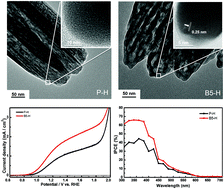Nanoporous hematite structures to overcome short diffusion lengths in water splitting†
Abstract
In this report, we show that by creating a nanoporous haematite (α-Fe2O3) structure using boric acid (H3BO3) treatment, the chronic issue of the short diffusion length of carriers in α-Fe2O3 for photoelectrochemical (PEC) applications can be successfully addressed. The slow release of Fe3+ ions because of the presence of H3BO3 leads to the creation of smaller dimension FeOOH nanorods, creating nanoporous α-Fe2O3 nanorods, composed of ∼15 nm α-Fe2O3 domains. The nanoporous α-Fe2O3 suppresses recombination by providing the facile extraction of holes from the surface of favorably sized α-Fe2O3 domains. The optimized nanoporous sample showed a photocurrent density of 1.41 mA cm−2 at a reversible hydrogen electrode of 1.23 V, which is 1.7 times higher than that of pristine hematite. The electrochemical impedance spectroscopy and incident photon-to-current efficiency data, and Mott–Schottky plots confirmed the superior performance of the nanoporous samples. Our impressive results may pave the way for designing devices for advanced energy conversion applications as well as fabricating a high efficiency hematite-based PEC system.


 Please wait while we load your content...
Please wait while we load your content...